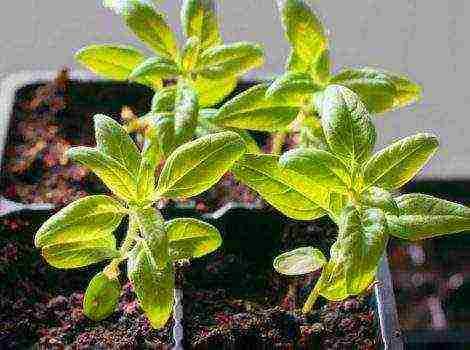Content
- 1 Hyacinth: botanical description
- 2 Eastern hyacinth: description
- 3 Popular varieties
- 4 What is distillation?
- 5 Bulb selection
- 6 Preparing the bulbs for planting
- 7 Landing dates
- 8 Planting bulbs
- 9 Potted hyacinth: home care during flowering
- 10 What to do with the bulb after flowering?
- 11 Preparing for growing hyacinth at home
- 12 Planting and caring for hyacinths indoors
- 13 How to care for hyacinth at home?
- 14 Forcing hyacinths at home
- 15 What to do after hyacinth blooms?
- 16 Reproduction of hyacinths at home
The stately and showy hyacinth is a real decoration of the garden in early spring. Appearing on a flower bed one of the first, when there is still snow in some places, it pleases those around it with large and fragrant flowers of the most diverse range of shades and shapes. Such splendor on a miniature scale can be easily repeated in winter, delighting yourself, relatives and friends with a magnificent gift for the New Year or Christmas. How the plant is distilled, how to care for hyacinth at home - recommendations in our article.
Hyacinth: botanical description

Hyacinth is a genus of bulbous perennial plants that belongs to the Asparagus family and includes only three species. They all have a distinctive look and fragrant flowers. The plant's bulb is dense, consisting of fleshy leaves, the bases of which occupy the entire circumference of the bottom. The stem is thick and dense, with an inflorescence at the top. After the end of flowering, he dies off along with the leaves with him. Very fragrant flowers are collected in a raceme, the perianth is brightly colored, in the form of a bell-shaped funnel with bent lobes. The fruit is a three-celled capsule. There are three known species: Hyacinthus transcaspicus, Litvinova and eastern. The latter is the most common and famous, which became the basis for breeding many varieties and hybrids. It is possible to care and plant hyacinth at home in a pot or in open ground.
Eastern hyacinth: description
It is considered to be a type species of the genus, that is, acting as a nomenclature species. In the event of any disputable situation, he acts as the only carrier of the generic name from an objective point of view. The homeland of the plant is the Mediterranean and Asia Minor. However, at the moment it is cultivated everywhere, not only as a decorative quality, but also as a medicinal one. The plant is perennial, bulbous, up to 30 cm high and up to 0.5 cm thick stele, fleshy linear leaves, has a bell-shaped flower. Hyacinth, home care for which is quite simple, blooms in early spring one of the first in the garden. In culture, it has become especially popular since the 15th century in Europe, since then more than three hundred high-quality and proven varieties have been bred. The Netherlands is famous for breeding hyacinths, especially the Haarlem region, from which millions of bulbs of these flowers come to the world market every year.
Popular varieties

It is difficult to say in a few sentences about the huge assortment of hyacinth varieties. When choosing one for your home or garden, pay attention to the manufacturer, seller, and botanical characteristics (height, flowering time, suitability for forcing, etc.). Planting and caring for hyacinths at home involves the choice of a certain hybrid. We offer a conditional division of varieties by color of flowers.
- White: Argentina Arendsen (up to 28 cm, diameter of an individual flower up to 4 cm), L'Innosance (an early old variety created in Holland in 1863, height up to 26 cm), Carnegie (medium-sized - up to 22 cm, cylindrical inflorescence ), Edelweiss (medium early, up to 25 cm, with a wide brush).
- Pink: Anna Marie (late, up to 25 cm high), Fondant (industrial variety with large 20 cm inflorescences, photo above), Pink Pearl (early, cone-shaped inflorescence with characteristic long bracts), China Pink, Marconi.
- Blue: King of the Blues (old Dutch variety 1865, late, pictured below), Delft Blue (up to 20 cm, suitable for distillation, long flowering period), Maria (up to 25 cm, deep dark blue, one of the most common hybrids), Myosotis (early, pale blue).
- Violet: Amethyst (short flowering period, unpretentious, pale lilac hue, height up to 25 cm), Bismarck (early, up to 30 cm light purple inflorescence, ideal for forcing and cutting), Menelik (purple-black, compact, late) ...
- Yellow: City of Harlem, Orange Bowen, Yellow Hammer.
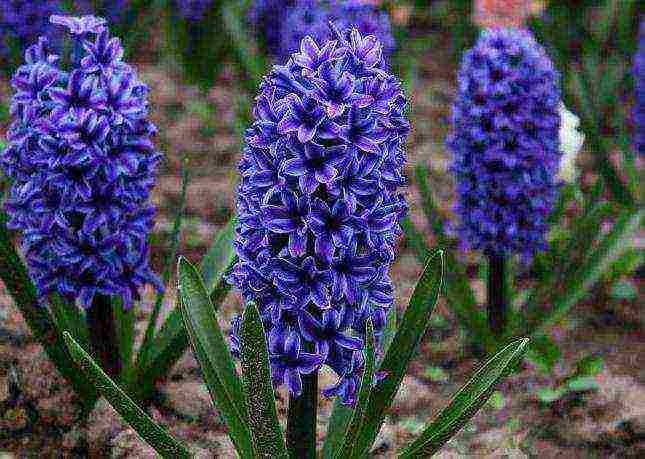
Lush, spectacular blooms, bright colors and a unique thick and rich aroma are the main reasons why hyacinth is grown in a pot. Home care is quite simple, but it involves distillation, in connection with which some peculiarities appear. They try to get a flowering plant, as a rule, for a certain holiday: New Year, March 8, etc.
What is distillation?
This process involves complex measures to accelerate plant growth. It is widely used in greenhouse cultivation and floriculture. The plant is placed in conditions with a high ambient temperature, humidity and is additionally illuminated, thereby stimulating them to active development, flowering and fruiting. It is in this way that tulips, daffodils, lilies and hyacinth in a pot are grown at home. How to save the plant after a similar procedure, read further in the text.
Bulb selection
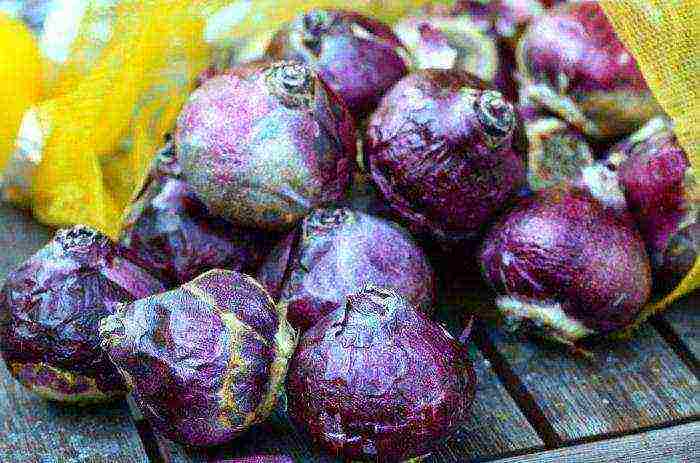
In fact, forcing mobilizes all the forces of the plant and allows you to get beautiful flowers in a short time. Only healthy and strong specimens can withstand this. Choose quality planting material, large, dense, undamaged bulbs grown outdoors. Pay attention to the weight, it should not be too light and give the impression of emptiness inside. In addition, as mentioned above, it makes sense to pay attention to the variety, there are hybrids specially designed for forcing.
Preparing the bulbs for planting
The preparation of hyacinth bulbs begins in the summer, at the moment when you decide that you will grow hyacinth in a pot (home care - hereinafter in the text). As soon as the foliage is dry, the planting material must be dug up, washed in warm water and dried in a draft in a shady place, and then stored in a cool and dry basement or cellar. Experienced flower growers know one secret. As soon as hyacinth flower stalks appear on the flowerbed in spring, they notice the largest and most powerful ones, but they are not allowed to bloom and are cut off. This allows the plant to use all its strength to develop the bulb, which can then be successfully driven out in winter.
Landing dates
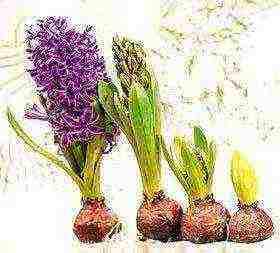
The timing of planting the bulbs in the ground directly depends on when exactly you want to get blooming hyacinths on your window. Care and growing at home in the future are quite simple, it is important to do everything right at the initial stage. The cooling period for forcing in the early stages is 10-13 weeks, for later varieties it increases to 12-16. The start date can be set as follows. Determine the day when you need to get the flower and in the reverse order subtract the number of weeks set from it, plus another 3-4 for growth for early and late varieties, respectively.
In order to strengthen the immune system, the bulbs should be placed for 30 minutes in a solution of potassium permanganate or the drug "Hom" (concentration - 4 g per 1 liter of water) before planting.
Planting bulbs
In accordance with the planned flowering time in the fall, the soil bulbs should be planted in the soil (purchased or prepared yourself).Use individual pots or group planting, depending on your preference. Hyacinth in a pot, home care is minimal, but its flowering is great. Fill the pots almost to the top with soil, then plant the onion so that the top is level with the edges of the crockery. When planting in groups, observe a distance of 2.5-3 cm. Cover the top of the pot with dark plastic, making holes for ventilation. Transfer the plants to a dark and cool place for a specified period, the temperature of the content should be within 5-8 ° C.
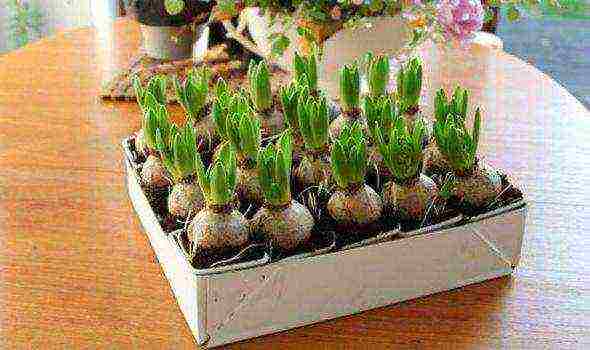
As the earthy clod dries, slightly moisten it, the soil should be slightly moist. During this time, small sprouts appear in the hyacinth, when they reach 3-5 cm in height, the plants should be brought into the house. The initial temperature of the content should not exceed 12 ° C, choose a shaded place for several days, and then move them closer to the window (but not the heating radiators). The pot is placed in a permanent place at the moment when buds appear on the plant.
Potted hyacinth: home care during flowering
In order for a plant to please you with a beautiful flowering, it needs to provide stable conditions for keeping. After the buds appear, the hyacinth pot is rearranged to a permanent light, protected from drafts. The temperature should be in the range of 15-20 ° С, keep the soil in a constantly moist state, not allowing it to dry out. Carry out a single feeding with complex mineral fertilizer, strictly observing the dosage and concentration indicated on the package.
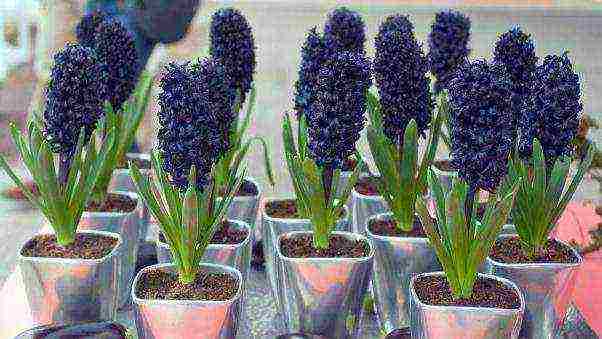
What to do with the bulb after flowering?
The hyacinth bulb used for forcing cannot be reused. However, you can plant it in open ground in a flowerbed in the garden, where it will delight you with natural flowering in early spring. After the forcing is over and the desired result is obtained, leave the bulb in the ground - this is necessary in order to preserve the flower. Hyacinth in a pot, home care assumes the same as in the soil. Continue watering and fertilizing the plant until the leaves begin to wither. After they dry, carefully separate them. Remove the onion from the ground, dry it and store it in a cool and dry place. Carry out planting in the ground in late autumn: in the middle or end of October, when the soil temperature drops to 5-10 ° C. Thus, hyacinth will have time to give roots before severe cold weather.
Remember that the plant prefers a sunny and open area, possibly lightly shaded, protected from wind and excess moisture. The soil is recommended loose, containing sand, humus, and having good moisture permeability.
 Hyacinth is a bulbous plant that can be successfully grown both in the garden and at home. Therefore, many amateur flower growers want to grow this flower on their windowsill in order to admire it even in winter, during the cold season. Such a desire is quite feasible. However, for the successful cultivation of the hyacinth, it is necessary to create the appropriate conditions, as much as possible like garden ones, and provide it with proper care.
Hyacinth is a bulbous plant that can be successfully grown both in the garden and at home. Therefore, many amateur flower growers want to grow this flower on their windowsill in order to admire it even in winter, during the cold season. Such a desire is quite feasible. However, for the successful cultivation of the hyacinth, it is necessary to create the appropriate conditions, as much as possible like garden ones, and provide it with proper care.
Preparing for growing hyacinth at home
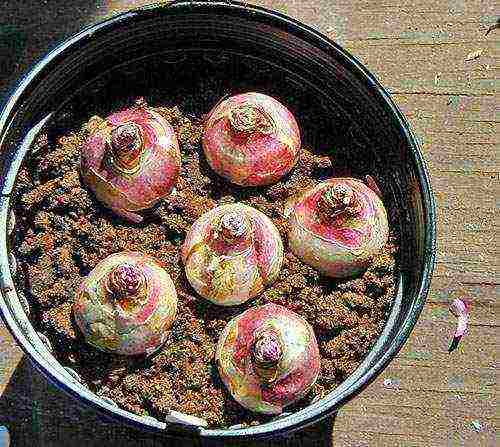 To date, breeders have bred several dozen varieties of hyacinth. And most of them are suitable for home cultivation. But in order to grow a strong and beautiful flower, you need to properly prepare:
To date, breeders have bred several dozen varieties of hyacinth. And most of them are suitable for home cultivation. But in order to grow a strong and beautiful flower, you need to properly prepare:
- Bulb selection... First you need to select a suitable material for planting. It is recommended to use bulbs with a minimum diameter of 5 cm. Because it is easier to grow a full-fledged plant from a large bulb. A small bulb may discard leaves, but may not produce flowers, and care must be taken to ensure that it is firm and free of rot or damage.And immediately before planting, it is advisable to treat it with a disinfectant solution.
- Pot selection... Then you need to choose the appropriate pot. It should be wide and shallow. The pot must have drainage holes.
- Soil preparation... You can buy the soil or prepare it yourself. To do this, mix in equal proportions turf, compost, leafy soil, humus and add a small amount of sand and peat.
When growing hyacinth at home, there is one caveat - this flower cannot bloom for several years in a row. Flowering is stimulated by artificial forcing, which weakens the bulbs. Therefore, after 1-2 years, they need to be planted in the garden area so that they go through the recovery period.
Planting and caring for hyacinths indoors
 After preparing the necessary materials, you can start planting the bulbs. Correct planting and caring for hyacinths indoors includes the following steps:
After preparing the necessary materials, you can start planting the bulbs. Correct planting and caring for hyacinths indoors includes the following steps:
- A drainage layer is laid out at the bottom of the pot; expanded clay is well suited for these purposes.
- A small layer of soil is covered.
- Then a thin layer of fine sand is placed.
- Bulbs are placed on top of the sand. You can plant one bulb in a pot, or several, so that a whole bouquet forms during flowering. In the latter case, the bulbs are laid out so that they do not come into contact with each other and with the pot (the optimal distance is 2-3 cm).
- The bulbs are gently pressed into the ground and covered with the remaining earth. From above, the soil can be sprinkled with a thin layer of sand to protect the planting material from decay.
The bulbs are not completely submerged in the soil; their tops must be left in the air.
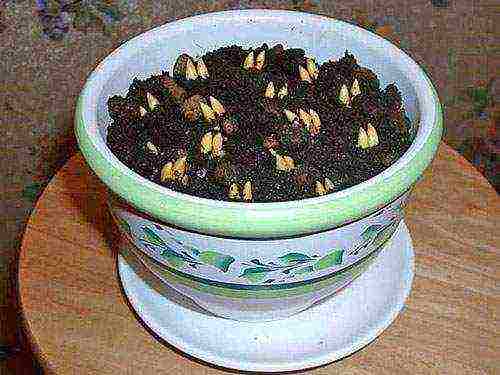 A dormant period is now created for the plants so that the bulbs take root well. The pot is placed for 1.5-2.5 months in a dark and cool place, such as a basement. The air temperature in this room should be between +5 and +10 degrees. In the absence of a basement or cellar, flowers can be placed in the refrigerator. However, it is imperative to ensure that the temperature in it is at least 5 degrees Celsius. During this period, it is necessary to monitor the condition of the soil in order to prevent it from drying out.
A dormant period is now created for the plants so that the bulbs take root well. The pot is placed for 1.5-2.5 months in a dark and cool place, such as a basement. The air temperature in this room should be between +5 and +10 degrees. In the absence of a basement or cellar, flowers can be placed in the refrigerator. However, it is imperative to ensure that the temperature in it is at least 5 degrees Celsius. During this period, it is necessary to monitor the condition of the soil in order to prevent it from drying out.
A dormant period is necessary for the successful cultivation of hyacinths in indoor conditions. If the plant is brought out earlier “into the light”, it may still be weak, develop poorly and, as a result, not bloom. Overexposure in the dark is also not recommended. The plant will throw out the leaves, all the power will go into them, and as a result, the formation of buds will be delayed.
After the rooting of the bulbs, an artificial spring is arranged for the hyacinths, for this the flowers are moved into the house. Here hyacinths should be kept in a bright room with a recommended air temperature of + 10-15 degrees.
As soon as the plant begins to bloom, it is transferred to the desired room and placed away from the radiators. In order for the hyacinth to delight the owners for a long time with lush, luxurious flowers, the air temperature should be no higher than +20 degrees. In addition, it is necessary to exclude the existence of drafts and provide the plant with good lighting.
How to care for hyacinth at home?
 To grow lush, beautiful flowers, you need to take care of them. How to care for a hyacinth at home so that it blooms as soon as possible and pleases the owners for a long time with beautiful flowers?
To grow lush, beautiful flowers, you need to take care of them. How to care for a hyacinth at home so that it blooms as soon as possible and pleases the owners for a long time with beautiful flowers?
Hyacinth care is relatively simple, and includes three essential components:
- watering;
- good lighting;
- fertilizer.
Watering. The basis of hyacinth care in indoor conditions is competent watering. The ground must be moist, so it is necessary to carefully monitor so that it does not dry out, and water the plant in a timely manner. This requirement is important during growth, flowering and overwintering. However, stagnant water for this plant is also destructive and can provoke a fungal infection.Therefore, you need to make sure that excess water goes into the sump, and be sure to drain it from there.
During watering, you only need to moisten the soil, and make sure that water does not get on the buds, onion and in the leaf axils. To do this, it is recommended to pour water into the edge of the pot, or the pan.
 Good lighting. From time to time it is necessary to turn the flower to the lighting in different directions. This contributes to the uniform growth of the plant. In the evening and on cloudy days, you can additionally illuminate the plant using fluorescent lamps. With a lack of lighting, the plant can wither, discard leaves and young buds.
Good lighting. From time to time it is necessary to turn the flower to the lighting in different directions. This contributes to the uniform growth of the plant. In the evening and on cloudy days, you can additionally illuminate the plant using fluorescent lamps. With a lack of lighting, the plant can wither, discard leaves and young buds.
Fertilizer. It is recommended to feed hyacinths 2 times a month. For this, special fertilizers are used, which are diluted according to the instructions.
Forcing hyacinths at home
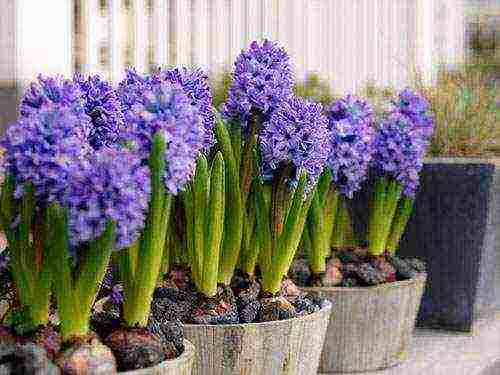 A nice feature of hyacinth is the ability to combine its flowering with a certain period or holiday. For this, hyacinths are distilled at home. It is of three types:
A nice feature of hyacinth is the ability to combine its flowering with a certain period or holiday. For this, hyacinths are distilled at home. It is of three types:
- early - the bulbs are planted in October, and the hyacinth blooms by the New Year;
- medium - planting is carried out in November, and flowering falls at the end of January - beginning of February;
- late - the bulbs are planted in December - January and admire the flowers in March - April.
The period from planting to flowering averages 2.5–3 months.
For the safe forcing of hyacinths at home, the bulbs must go through several stages of preparation with a gradual decrease in air temperature. After digging, they should be stored for 2 weeks in a warm and humid place with an air temperature of + 28-30 degrees. Then for 2 weeks they are placed in a cool room with a temperature of + 22-25 degrees. Further, even colder conditions are created for 2 weeks - + 15-17 degrees. And after that, the bulbs are ready for planting in a pot.
What to do after hyacinth blooms?
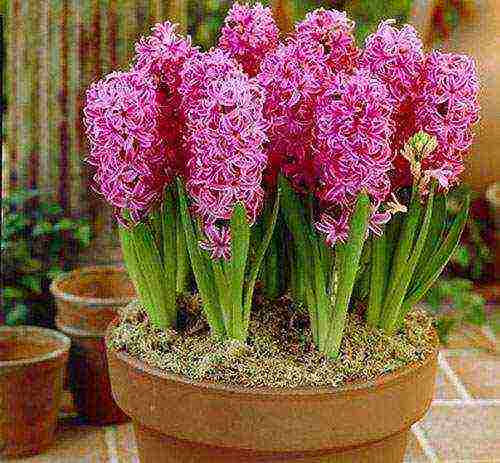 Like all flowering plants, hyacinth fades over time. What to do with hyacinth after flowering at home? To keep him alive, you need to cut the flower stalks and do not stop watering and fertilizing the plant until the leaves completely wither. At this time, the mother bulb is restored and can form daughter bulbs.
Like all flowering plants, hyacinth fades over time. What to do with hyacinth after flowering at home? To keep him alive, you need to cut the flower stalks and do not stop watering and fertilizing the plant until the leaves completely wither. At this time, the mother bulb is restored and can form daughter bulbs.
Then you need to remove the hyacinth from the ground, clean it of wilted leaves and put the bulb to dry for 2-3 days. If, after digging up the bulbs, the babies are already well developed, you can separate them. If they do not detach well, it is better not to touch them until next year. Since it is advisable not to use faded bulbs for re-distillation, they are transplanted to a garden plot. Planting is carried out in the fall, and next year they are already delighting the owners with flowers in the flowerbed.
To obtain bulbs that can be used for indoor cultivation, the plant is not allowed to bloom normally. The buds are cut off so that the bulb can recover. In the fall, they take it out of the ground, dry it, and again carry out the forcing procedure.
Reproduction of hyacinths at home
 Hyacinth is propagated by children (daughter bulbs), which are carefully detached from the adult bulb. Natural division occurs slowly, in one year the mother's bulb can form a maximum of 4 babies. Therefore, in floriculture, an artificial method of reproduction of hyacinths is used at home. To quickly get a large number of children, they practice special techniques - cutting and notching the bottom.
Hyacinth is propagated by children (daughter bulbs), which are carefully detached from the adult bulb. Natural division occurs slowly, in one year the mother's bulb can form a maximum of 4 babies. Therefore, in floriculture, an artificial method of reproduction of hyacinths is used at home. To quickly get a large number of children, they practice special techniques - cutting and notching the bottom.
Before starting artificial propagation, the bulbs are treated with a 1% solution of potassium permanganate and dried at an air temperature of + 20-23 degrees for 2-3 days.
Cutting the bottom... This technique is carried out after a period of rest. With a teaspoon in the onions, carefully cut out the bottom, then store them in boxes with a cut upwards at an air temperature of at least +21 degrees. After 2-3 months, small babies in the amount of 20-40 pieces begin to form on the sections.
After the appearance of the children, the bulb is planted in a cool greenhouse. Young bulbs begin to grow and discard the first leaves. After the growing season, they are taken out of the ground, separated and planted for growing. After 3-4 years, ripe bulbs throw out their first flower stalks.
Cutting the bottom. This method is similar to the previous one, with the difference that the base is not cut out, but 2–4 cuts are made in it, 0.5–0.6 cm deep. Processing and storage conditions are the same as in the first method. With this method, the number of children decreases (8–15 pcs.), But they will be larger and stronger. The growing period in this case is reduced to 2-3 years.
The process of growing hyacinths at home is quite simple, but very fruitful. To successfully complete it, you need to have a lot of desire and a little patience. And, of course, follow all the rules and recommendations that relate to planting and caring for hyacinths in indoor conditions.
How to grow hyacinths at home - video
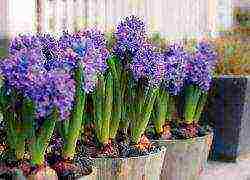
In winter, when it is so cold outside the window, I especially want the smell of spring in the house. And to achieve this is quite simple - you just have to settle a hyacinth on the windowsill. This bright and very fragrant plant is also remarkable because its flowering can be tailored to any desired date. Growing hyacinths at home will be discussed in our article.
How to grow hyacinths at home?
Many of us are not sure if it is possible to keep hyacinths at home? Of course you can - this initially wild plant grows well not only in the garden, but also on the windowsill, you just need to create the necessary growing conditions for the hyacinth and strictly follow all agricultural techniques.
Stage 1 - Seed Selection
To grow a handsome hyacinth at home, the first thing you need is a strong healthy bulb, at least 5 cm in girth. It is this kind of seed that is needed to get a strong plant with a strong peduncle. It is best to buy hyacinth bulbs from trusted flower shops, where they are most likely stored in the right conditions.
Stage 2 - planting hyacinth
You can grow hyacinth at home both in a regular pot and in water. In the first case, a small pot (10-12 cm in diameter) is needed for the hyacinth. You can also plant several bulbs in one container so that the distance between them is at least 3 cm. Do not allow the bulbs to touch the pot walls. A thick layer of drainage is laid at the bottom of the pot, then a layer of soil mixture is poured. Any soil mixture for growing hyacinth can be used, as long as its acidity is not too high. A layer of sand is spread on top of the soil mixture, then the bulb is placed and lightly pressed into the pot. As a result, the bulb should rise at least 1/3 above the soil layer.
In the case of aquatic cultivation, hyacinth is placed in a narrow container with a nutrient solution (water + fertilizer) so that it touches the liquid only at the bottom.
Stage 3 - forcing the hyacinth
Whichever method of growing hyacinth is chosen, it must go through such a stage of development as a dormant period - a bulb planted in the ground or water is sent to a dark and cold (+ 5 ... + 7 ° C) room, where it will slowly germinate throughout 2-2.5 months. Only after the leaves hatch from the bulb, it is transferred to a room with a higher temperature (+10 .. + 15 ° C). If you do not wait for the leaves to appear and bring the bulb into the heat earlier, and even put it under good lighting, you can not wait for the hyacinth to bloom at all.
Stage 4 - leaving
Now let's take a closer look at how to care for a hyacinth at home during the growth period. After the pot with the hatched onion has been removed from the cold, it is moved to a bright and warm (+ 15 ° C) room. In these conditions, the hyacinth will remain until the moment it releases an arrow with buds.After the appearance of the long-awaited buds, the hyacinth can be sent to the place chosen for it - a window sill or a table, placing it away from drafts and the heat of heating appliances. 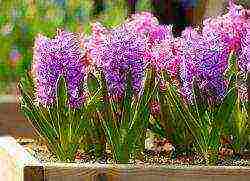 During the flowering period, you need to care for the hyacinth in no other way than by regularly watering it. Watering the hyacinth should be extremely careful not to let the water get on the leaves or bulb. Periodically, the hyacinth is rotated around its axis to evenly illuminate it.
During the flowering period, you need to care for the hyacinth in no other way than by regularly watering it. Watering the hyacinth should be extremely careful not to let the water get on the leaves or bulb. Periodically, the hyacinth is rotated around its axis to evenly illuminate it.
Stage 5 - care of faded hyacinth
After the end of the flowering of the hyacinth, the peduncle must be carefully cut off and continue caring for the plant until the leaves wither. Although the distilled bulb is not able to bloom a second time, it can be used for propagation. To do this, the bulb is carefully removed from the pot in order to plant it in the open ground in the fall. There, in the wild, she will successfully give birth to offspring.
Hyacinth plant
Hyacinth is a beautiful flower that can be grown not only outdoors but also at home. The name of this plant is translated as "rain flower". Many growers wonder how to grow hyacinth at home from a bulb in a pot, but rarely anyone is interested in the history of the flower. This flower originated a very long time ago in distant Ancient Greece. If you believe the myth, then the flower arose under very sad circumstances. This legend concerns the king Amiklos, whom fate has awarded with a wonderful son. He was just great. As a result, the gods Apollo and Zephyr began to experience burning jealousy towards the young man. This led to the fact that one of the deities simply killed the young man. In the place where the blood of the son of King Amiklos dripped, beautiful flowers arose. Later this plant was called hyacinth. In this article, we will talk with you how to grow hyacinth at home in a pot from an onion and how to do it all right.
What does hyacinth look like?
Before you start growing hyacinth at home, you should study a little basic information. This plant is considered by many to belong to the lily family. This flower grows well both at home and in the wild. Most often, the hyacinth flower is found in the Eastern Mediterranean, North America, Central Asia. The plant grows out of a bulb. A thick stem grows in the center of the hyacinth bulb, which is surrounded by large, fleshy leaves. This stem usually has an inflorescence, which can be of almost any color. One plant can produce several stems at once. However, this is extremely rare.
In shape, the flowers resemble small strongly open bells. One hyacinth inflorescence can contain about 30 flowers. After the plant has faded, its stems dry out. At the same time, a young one is born inside the old bulb. Daughters usually grow on a young bulb. A plant planted from a daughter bulb in a pot does not begin to bloom until three years later.
Growing hyacinth
Potted hyacinth
If you live in climatic conditions that do not allow you to grow hyacinth in nature, then you should not be upset, as growing hyacinth in pots from a bulb at home. It is worth noting that the plant is quite common among amateur flower growers. Hyacinth usually blooms from early January to late May. For plant growth, it is necessary to prepare a special soil. Most of all, hyacinth loves clay-sod soil. It is also worth adding coarse sand to the soil for the flower. It should make up two-thirds of all soil. To grow hyacinth in pots at home, you must also observe the temperature regime. For the development of a flower, it is worth adhering to a temperature of 10 to 16 ° C. Lighting is also important for the flower. During the flowering period, he just needs a bright light. Watering should be regular. But at the same time, it is worth making sure that no water stagnates in the hyacinth pot. The plant needs feeding once a month.For these purposes, mineral fertilizer is perfect.
Until the hyacinth blooms, it is better to keep it in the shade, where it is cooler. After the plant begins to bloom, the air temperature is not so important. However, keep in mind that in a cooler room, the plant will bloom for much longer. After flowering, it is better to transfer the flower bulb to a darker and cooler place. You can plant a hyacinth bulb again in early autumn. The plant propagates only by bulbs. After you grow this beautiful flower, you may find out how to care for plants and flowers and how to do it right.
How to grow hyacinth from a bulb
At the end of August, choose large and healthy bulbs. Now we will learn how to grow hyacinth from a bulb at home. Wrap them in cheesecloth and leave in the refrigerator for a while. In this case, the temperature must be maintained at 5 ° C. Care must be taken in the first autumn months to prevent the hyacinth bulb from getting sick.
You can start planting a hyacinth bulb in a pot in early November. In advance, you need to prepare a pot no more than 30 centimeters high. The diameter of the pot depends on the number of bulbs you will be planting.
The container must be filled with soil and tamped. The layer height should be 10 centimeters. After that, the soil must be watered. Lay out the plants prepared for planting on its surface, and then sprinkle them with a layer of soil. In this case, the bulbs should look out from under it. After planting, place the plant pot in a cool place or in the refrigerator. The plant should melt in the cold for about a month.
Hyacinth bulb
To properly grow hyacinth at home, you must adhere to strict rules. Otherwise, the plant may get sick or simply die. In early December, the planted flowers can be transferred to a room where the air temperature does not exceed 16 ° C. In this case, you should not expose the pot immediately to bright light. It is worth noting that hyacinth is a rather capricious plant in terms of lighting. That is why you should closely monitor the flower for 10 days. When the first shoots reach three centimeters, you can start to moderate watering. Plants also need bright light at this point.
In January, the hyacinth sprouts should already get stronger. Also during this period, the first inflorescences appear. It is worth noting that the flower bud at this moment has the same shade as future flowers. Flowers will start blooming very soon. When the plant is fully blooming, it is necessary to transfer it to a warm room.
After flowering, the stem of the home hyacinth can be cut off. But you shouldn't touch the leaves. Indeed, without them, a young bulb simply cannot form. To prevent the leaves from breaking, they should be tied up. During this period, the plant requires moderate watering and feeding. Feeding should be done monthly. This should be done until the leaves of the plant begin to dry out.
Cutting the leaves of hyacinth is only worth their complete drying. Dry leaves are the first sign that a bulb has formed. The bulb should be removed from the ground and placed in a cool place, but not in the refrigerator. You can plant a new onion only after a couple of years, since it must gain strength before distilling. After the shelf life is over, the hyacinth should be planted in early autumn. Here are perhaps all the basic recommendations on how to properly grow hyacinth in pots from a bulb at home. Good luck to you!


